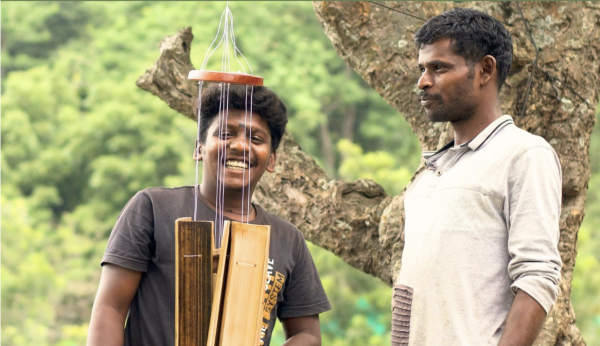Neo-Futurist Member Teaches Obies Non-Illusory Performance
A scathing monologue about the zodiac signs. A somber mathematical proof about the square root of two and the mysteries of human behavior. A carefree dance to “Shark Smile” by Big Thief. An unabashed cover of “Somebody to Love” by Queen, but performed in a pitch-black room.
All these and more were the 38 short performances in Staging the Real, an on-campus Winter Term project and that went up for one night only on Jan. 31.
Staging the Real incorporated the principles of neo-futurism and non-illusory performance. Both styles embrace the limitations of theater and do not attempt to project the illusion of a character or setting.
Joey Rizzolo, OC ’97, was the project facilitator leading the 16 student participants. While at Oberlin, he was a Theater major and did performance art. His work at Oberlin led him to teach theater and work with the New York Neo-Futurists, a performance group specializing in the performance aesthetic that was pioneered by Greg Allen, OC ’84.
“The performers aren’t pretending anything,” Rizzolo said about non-illusory performance. “They don’t pretend to be people that they’re not. They don’t pretend to be in a space that they’re not. They don’t pretend that they’re doing anything they’re not actually doing; all of their actions are real, executable, failable tasks. And they acknowledge the reality of the circumstances all the time, which includes the audience and sometimes involves the audience.”
Rizzolo was first introduced to the Neo-Futurists through its sister company, the Chicago Neo-Futurists, shortly after his time at Oberlin.
“It’s also exciting when you see somebody create something that’s never been seen before. And that’s what’s alluring to me about performance art: Because it’s not attached to any one medium, everything is on that palette. It’s kind of like the Wild West of art, all the time.”
Since moving from New York City to Oberlin in July of last year, Rizzolo now serves as the associate artistic director of the Oberlin Summer Theater Festival and an adjunct professor for the Theater department. When Staging the Real’s faculty advisor, Paul Moser, approached him about leading a project, Rizzolo decided to introduce current Obies to performance art.
Although the 16 students were a mix of composers, performers, writers, and choreographers, they were united by their desire to engage in other disciplines as artists during their Winter Term collaboration.
The four-week-long project involved students writing and performing original performances, with a heavy emphasis on group work, constructive criticism, and continual revision.
“I thought this Winter Term would help me get out of a creative rut I’ve been in, while also inspiring me to do work outside of my main artistic disciplines,” said Michelle Tyson, a second-year College student and Musical Studies major. “It was nice to have a strict, structured program to do art within.”
The non-illusory nature of the performance meant that a majority of the pieces were personal narratives.
One autobiographical piece was “Stage Fright” by College first-year So Asiddao, who used the act as a personal outlet for their performance anxiety. In “Stage Fright,” Asiddao sings and dances to “Somebody to Love” by Queen — but only after instructing the audience to close their eyes and telling Rizzolo to turn off the lights.
“I was dancing and doing my hair, basically trying to tempt the audience to open their eyes, but they weren’t allowed to,” Asiddao said. “It was about me singing, but it was also about a social experiment: Will they open their eyes, will they not open their eyes?”
While the final product of Staging the Real was the 38-act performance, the real focus of the project was the creative process. According to Asiddao, each student wrote roughly 30 pieces, but only one to three per individual made it into the final show.
Similarly, Rizzolo’s favorite day was when he split everyone into two teams of choreographers and composers, prompting them to either choreograph or compose a 60-second piece, before randomly pairing different pieces with each other. The resulting performances were surprising: despite the unconventional creative process, everything came together beautifully.
“Every single one of those pairings worked out extremely well,” Rizzolo said. “In fact, we used most of them in the final performance. They just fell into place.”
These spontaneous compositions appeared in the final show as “Thursday Afternoon,” “Untitled #12 (The Fan Piece),” and “Dressing Room.”
Above all, engaging in Staging the Real — learning to write and perform, accepting the reality of the stage, and performing either their own or their castmates’ biographies — brought everyone closer in the way only theater could.
“It was just a lot of really great collaboration. Everyone was super nice,” Asiddao said. “I became super close with people — people I think I’m going to be friends with forever.”










